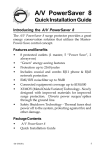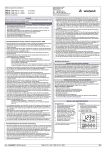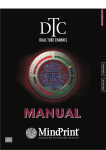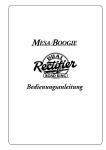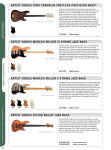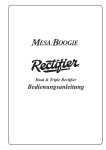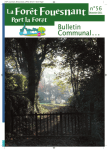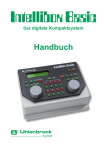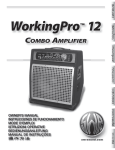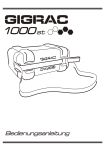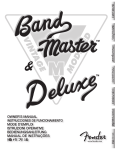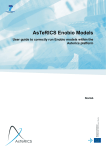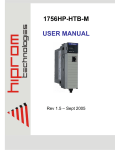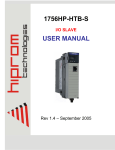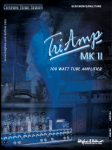Download Bad Bull 900/Bad Bull 2000
Transcript
>> Bedienungsanleitung Bad Bull 900 / Bad Bull 2000 WICHTIGE SICHERHEITSANWEISUNGEN! Alle Tecamp Geräte sind für einen dauerhaften, sicheren Betrieb ausgelegt. Wenn Sie sich an die folgenden Anweisungen halten, können Sie Schaden von sich, anderen und dem Gerät fernhalten. 1. Lesen Sie diese Sicherheitsanweisungen, bevor Sie das Gerät benutzen. 2. Verwahren Sie diese Anweisungen an einem sicheren Ort, um später immer wieder darauf zurückgreifen zu können. 3. Folgen Sie allen Warnhinweisen, um einen gesicherten Umgang mit dem Gerät zu gewährleisten. 4. Folgen Sie allen Anweisungen, die in dieser Bedienungsanleitung gemacht werden. 5. Betreiben Sie das Gerät nicht in der Nähe von Wasser oder in Umgebungen mit starker Kondenswasserbildung, z.B. im Badezimmer, in der Nähe von Waschbecken, Waschmaschinen, feuchten Kellern, Swimming Pools usw. 6. Verdecken Sie nicht die Lüftungsschlitze. Bauen Sie das Gerät so ein, wie der Hersteller es vorschreibt. Das Gerät sollte so aufgestellt werden, dass immer eine ausreichende Luftzufuhr gewährleistet ist. Zum Beispiel sollte das Gerät nicht im Bett, auf einem Kissen oder anderen Oberflächen betrieben werden, die die Lüftungsschlitze verdecken könnten, oder in einer festen Installation derart eingebaut werden, dass die warme Luft nicht mehr ungehindert abfließen kann. 7. Das Gerät sollte nicht in der Nähe von Wärmequellen betrieben werden (z.B. Heizkörper, Wärmespeicher, Öfen, starke Lichtquellen, Leistungsverstärker etc.). 8. Vermeiden Sie starke Temperaturschwankungen. 9. Achten Sie darauf, dass das Gerät immer geerdet und das Netzkabel nicht beschädigt ist. Entfernen Sie nicht mit Gewalt den Erdleiter des Netzsteckers. Bei einem Euro Stecker geschieht die Erdung über die beiden Metallzungen an beiden Seiten des Steckers. Die Erdung (der Schutzleiter) ist, wie der Name schon sagt, zu Ihrem Schutz da. Falls der mitgelieferte Stecker nicht in die örtliche Netzdose passt, lassen Sie den Stecker von einem Elektriker (und nur von einem Elektriker!) gegen einen passenden austauschen. 10.Schließen Sie den Verstärker nur an eine geerdete Steckdose mit der korrekten Netzspannung an. 11.Netzkabel sollten so verlegt werden, dass man nicht über sie stolpert, darauf herumtrampelt, oder dass sie womöglich von anderen spitzen oder schweren Gegenständen eingedrückt werden. Netzkabel dürfen nicht geknickt werden – achten Sie besonders auf einwandfreie Verlegung an der Stelle, wo das Kabel das Gerät verlässt sowie nahe am Stecker. 12.Verwenden Sie nur Originalzubehör und/oder solches, das vom Hersteller empfohlen wird. 13.Wird das verpackte Gerät mit einer Sackkarre transportiert, vermeiden Sie Verletzungen durch versehentliches Überkippen. 14.Ziehen Sie den Netzstecker bei Gewitter oder wenn es längere Zeit nicht gebraucht wird. 15.Das Gerät sollte unbedingt von nur geschultem Personal repariert werden, wenn: Das Netzkabel oder der Netzstecker beschädigt wurde, Gegenstände oder Flüssigkeiten in das Innere gelangt sind, das Gerät Regen ausgesetzt war, das Gerät offensichtlich nicht richtig funktioniert oder plötzlich anders als gewohnt reagiert, das Gerät hingefallen oder das Gehäuse beschädigt ist. Wartung: Der Anwender darf keine weiteren Wartungsarbeiten an dem Gerät vornehmen als in der Bedienungsanleitung angegeben. Sonstige Wartungsarbeiten dürfen nur von geschultem Personal durchgeführt werden. 16.Halten Sie das Gerät mit einem weichen, trockenen Lappen sauber. Wischen Sie es gelegentlich mit einem feuchten Tuch ab. Benutzen Sie keine anderen Reinigungs- oder Lösungsmittel, die die Lackierung oder die Plastikteile angreifen könnten. Regelmäßige Pflege und Überprüfung beschert Ihnen eine lange Lebensdauer und höchste Zuverlässigkeit. Entkabeln sie das Gerät vor der Reinigung. 17.Stellen Sie den Verstärker niemals auf eine Unterlage, die das Gewicht des Geräts nicht tragen kann. 18.Achten Sie immer darauf, dass die minimale Lastimpedanz der angeschlossenen Lautsprecher nicht unterschritten wird. 19.Vermeiden Sie hohe Lautstärken über einen längeren Zeitraum. Ihr Gehör kann massive Schäden davontragen – Hörverluste sind fortschreitend und irreversibel! VORSICHT: UM DIE GEFAHR VON STROMSCHLÄGEN ZU VERMEIDEN, ÖFFNEN SIE NICHT DAS GERÄT. ENTFERNEN SIE NIEMALS DIE ERDUNG AM NETZKABEL. SCHLIEßEN SIE DAS GERÄT NUR AN EINE ORDENTLICH GEERDETE STECKDOSE AN. WARNUNG: UM DIE GEFAHR VON STROMSCHLÄGEN ZU VERRINGERN, SETZEN SIE DAS GERÄT KEINER FEUCHTIGKEIT ODER SOGAR REGEN AUS. VORSICHT: IM INNEREN BEFINDEN SICH KEINE TEILE, ZU DENEN DER ANWENDER ZUGANG HABEN MUSS. REPARATUREN DÜRFEN NUR VON QUALIFIZIERTEM FACHPERSONAL DURCHGEFÜHRT WERDEN. VORSICHT: DIESES GERÄT IST IN DER LAGE, SEHR HOHE SCHALLDRÜCKE ZU ERZEUGEN. SETZEN SIE SICH NICHT LÄNGERE ZEIT HOHEN LAUTSTÄRKEN AUS, DIES KANN ZU BLEIBENDEN GEHÖRSCHÄDIGUNGEN FÜHREN. TRAGEN SIE UNBEDINGT GEHÖRSCHUTZ, WENN DAS GERÄT MIT HOHER LAUTSTÄRKE BETRIEBEN WIRD. ACHTUNG STROMSCHLAGGEFAHR, NICHT ÖFFNEN VORSICHT: UM DIE GEFAHR VON STROMSCHLÄGEN ZU VERMEIDEN, ENTFERNEN SIE KEINE ÄUSSEREN TEILE. DIESES GERÄT ENTHÄLT KEINE TEILE, ZU DENEN DER ANWENDER ZUGANG HABEN MÜSSTE. LASSEN SIE ALLE SERVICE LEISTUNGEN VON AUSGEBILDETEM FACHPERSONAL BEI EINER AUTORISIERTEN SERVICE WERKSTATT DURCHFÜHREN. BESCHREIBUNG DER SYMBOLE: GEFÄHRLICHE SPANNUNG: Dieses Dreieck mit dem Blitzsymbol auf Ihrem Gerät macht Sie auf nicht isolierte „gefährliche Spannungen“ im Inneren des Gerätes aufmerksam, stark genug um einen lebensbedrohlichen Stromschlag abzugeben. UNBEDINGT IN DER BEDIENUNGSANLEITUNG NACHSCHLAGEN: Dieses Dreieck mit dem Ausrufezeichen auf Ihrem Gerät weist Sie auf wichtige Bedienungs- und Pflegeanweisungen in den Begleitpapieren hin. WEEE: Entsorgung von gebrauchten elektrischen und elektronischen Geräten (anzuwenden in den Ländern der Europäischen Union und anderen europäischen Ländern mit einem separaten Sammelsystem für diese Geräte). Das Symbol auf dem Produkt oder seiner Verpackung weist darauf hin, dass dieses Produkt nicht als normaler Haushaltsabfall zu behandeln ist, sondern an einer Annahmestelle für das Recycling von elektrischen und elektronischen Geräten abgegeben werden muss. Durch Ihren Beitrag zum korrekten Entsorgen dieses Produkts schützen Sie die Umwelt und die Gesundheit Ihrer Mitmenschen. Umwelt und Gesundheit werden durch falsches Entsorgen gefährdet. Materialrecycling hilft den Verbrauch von Rohstoffen zu verringern. Weitere Informationen über das Recycling dieses Produkts erhalten Sie von Ihrer Gemeinde, den kommunalen Entsorgungsbetrieben oder dem Geschäft, in dem Sie das Produkt gekauft haben. >> Bad Bull Treibt man die Vorstufe des Bad Bull in den Zerrbereich, wird der Ton durch die Röhren milder in der Ansprache. Er bekommt eine angenehme Wärme und der «GAIN»Regler beschneidet bei weiterem Aufdrehen die Pegelspitzen. Die akribische Qualitätssicherung sorgt für absolute Betriebssicherheit. Der ausschließliche Einsatz hochwertigster Bauteile, die professionelle Verarbeitung und das einzigartige Konzept setzen den Bad Bull an die Spitze der Premium-Bassverstärker unserer Zeit. Sie können sich freuen, es ist soweit – Sie halten gerade die Bedienungsanleitung Ihres neuen TecAmp Bad Bull in den Händen. Der Bad Bull ist ein besonderer technischer Leckerbissen mit einer Fülle an innovativen Besonderheiten. Durch die Verbindung der edlen Röhrenvorstufe mit sechs Triodensystemen und der gewaltigen Power der digitalen Monster-Endstufe setzt der Bad Bull neue Maßstäbe in punkto Bassverstärkung. Ob Eingangssektion, Klangreglung, Kompressor, Effektwege oder symmetrischer DI-Ausgang – alle Wege, die das Bass-Signal nimmt, sind von höchster Qualität. Die zuschaltbare 6V6 Endstufenpentode sitzt zwischen Vorund Endstufe. Sie erweitert fein dosierbar den Sound mit typischer Endstufenröhren-Verzerrung. Der daraus entstehende Klang wird von der einzigartigen Dynamik der digitalen Endstufe mit souveräner Leichtigkeit ohne Einbußen auf höchste Pegel-Niveaus geliftet. ! EG-Konformitätserklärung für das Produkt/Type Bad Bull Bassamp Wir erklären in alleiniger Verantwortung als Hersteller, dass dieses Produkt unter Beachtung der Betriebsbedingungen und Einsatzumgebung laut Bedienungsanleitung mit den folgenden Normen oder normativen Dokumenten übereinstimmt: EN 61000-3-2, EN 61000-3-3, EN 55013, EN 55020, EN 55022, EN 60065 gemäß den Bestimmungen der Richtlinien 89/336/EWG und 73/23/EWG. 3 >> Front Panel Bad Bull 1 3 4 Gain Sub Hi 5 Gain 6 Bass Sub 7 LoMid Bass 8 Mid LoMid 9 HiMid High Mid ThresholdHigh HiMid Ratio 11 12a 12 Threshold Power Tube Ratio O IO O Lo O IO IO O O IO IO O O IO IO O O IO IO O O IO IO O O IO IO O O IO IO O O 3a 10 1 HI Stecken Sie den Klinkenstecker Ihres abgeschirmten Instrumentenkabels in die «HI»-Buchse, wenn Ihr Instrument mit passiven Tonabnehmern ausgestattet ist, oder über relativ wenig Ausgangsleistung verfügt. Aktive Instrumente, die an dieser Buchse angeschlossen werden, bringen den Bad Bull entsprechend früher in die Röhrensättigung. der Röhrenvorverstärker mit leichter Kompression und bei weiterem Aufdrehen mit weichen Verzerrungen. Aufgrund dieser Eigenschaften wurde auf eine Clip-LED verzichtet, da ein angezerrter Basssound mit harmonischen Obertönen oftmals durchaus willkommen ist. Stellen Sie den «VOLUME»-Regler Ihres Instruments nicht zu gering ein, da sich sonst Störungen auf dem Signalweg zum Bad Bull stärker bemerkbar machen. 2 LO 3a Magisches Auge Wenn Ihr Bass über eine aktive Elektronik verfügt, oder prinzipiell eine sehr hohe Ausgangsleistung hat, ist es ratsam, den «LO»-Eingang zu benutzen. Hier wird der Eingang um 10 dB bedämpft. Eine Bedämpfung im Eingang ermöglicht es, mit dem «GAIN»-Regler (#3) feinere Abstimmungen vornehmen zu können, da sich der Regelweg dadurch ändert – Sie können den «GAIN»-Regler nun weiter aufdrehen. Das Magische Auge (eine EM 84 Anzeigenröhre), das sich unter dem «GAIN»-Regler befindet, zeigt die Aussteuerung der Eingangsstufe des Bad Bull an. Wenn die beiden blaugrünen Leuchtbalken dieser Anzeigenröhre in der Mitte zusammentreffen, ist die maximale cleane Aussteuerung erreicht. Wird der «GAIN»-Regler jetzt weiter aufgedreht, kommen die harmonischen Röhrenverzerrungen der Vorstufe hinzu. 3 GAIN 4-9 Klangregelung Stellen Sie den «GAIN»-Regler anfänglich senkrecht auf Position 12 Uhr. Bei weit aufgedrehtem «GAIN» reagiert Das Schaltungskonzept der Klangregelung wird mit Induktivitäten realisiert. Dieser sechs-Band Spulen-Equalizer 4 On On Volume 2 MasterPower Tube Break 14 15 Master Break Hi On Lo 13a 13 IO O IO IO O On O IO IO O Volume Volume O IO O O IO IO O IO Volume IO O 12b IO 13b 3a 7 MID überzeugt durch feinste Ansprache und herausragendem Frequenzgang bei gleichzeitigem hohem Rauschabstand. Der «MID»-Regler bestimmt die Durchsetzungskraft im Bandgefüge bei Frequenzen um 800 Hz. Besonders geeignet, um den Frettless singen zu lassen, oder gewünschte Rückkopplung bei weit aufgedrehtem «GAIN» zu fördern. 4 SUB Der «SUB«-Regler nimmt Einfluss auf den sehr tiefen Bassbereich. Seine Center-Frequenz liegt bei 30 Hz. Hier sollte man wirklich vorsichtig sein, wenn Boxen zum Einsatz kommen, die der Belastung des Bad Bull nicht standhalten. Ein einziger Ton kann hier sofort zu Beschädigungen an den angeschlossenen Lautsprechern führen. 8 HiMID Der «Hi MID»-Regler übernimmt den oberen Mitteltonbereich bei Frequenzen um 3 KHz. Dies hebt beim Aufdrehen (speziell beim Plektrum-Spiel) den typischen Anschlag-Attack hervor. 5 BASS Der «BASS»-Regler regelt die Anhebung bzw. Absenkung der Frequenzen um 80 Hz. Er bringt den mächtigen Bassdruck, der in dieser Klarheit nur von einer Röhrenvorstufe erzeugt werden kann. 9 HIGH Der «HIGH»-Regler regelt die Frequenzen bei 10 KHz. Hier können die obersten Brillanzen bedämpft oder angehoben werden. 6 LoMID 10 Bull Eyes Der «Lo MID»-Regler nimmt Einfluss auf die Durchsetzungskraft des Bass-Sounds im Tiefmittenbereich bei Frequenzen um 200 Hz. Sehr gut geeignet, um auch problematische Raumresonanzen in den Griff zu bekommen. Die beiden Augen des Bad Bull-Logos auf der Frontseite leuchten rot, wenn der Verstärker eingeschaltet ist. Wenn das mitgelieferte Netzkabel an der auf der Rück- 5 >> Front Panel Bad Bull 1 3 4 Gain Sub Hi 5 Gain 6 Bass Sub 7 LoMid Bass Mid 8 LoMid 9 HiMid High Mid ThresholdHigh HiMid Ratio 11 12a 12 Threshold Power Tube Ratio O IO O Lo O IO IO O O IO IO O O IO IO O O IO IO O O IO IO O O IO IO O O IO IO O O 3a 10 Der «THRESHOLD»-Regler ist in Verbindung mit dem «RATIO»-Regler (#12) die Reglereinheit, um den eingebauten Röhrenkompressor abzustimmen. Ist der Regler zugedreht (gegen den Uhrzeigersinn), wird kein Einfluss auf das Signal genommen. Beim Aufdrehen werden die Pegelspitzen des Bass-Signals oberhalb der durch den «RATIO»-Regler (#12) festgelegten Größe komprimiert. tes justierbar. Während der Ratio-Regler (#12) das Verhältnis der Kompression zum Signalpegel einstellt, regelt der Volume-Regler die Gesamtlautstärke des Compressor-Effektes. Somit ist ein, zuvor in der Lautstärke eingestellter, Compressor-Effekt via Fußschalter abrufbar. Der Schalter (#12a) aktiviert den Compressor. Der Schalter korrespondiert mit der Footswitch-Buchse (#26) über die, mittels des optional erhältlichen Fußschalters FS BAD BULL, die Funktion fernbedienbar ist. Ist der Fußschalter an der Footswitch-Buchse angeschlossen, hat dieser Vorrang, d. h. der Schalter (#12a) und die LED Anzeige ist nicht aktiv. Der Schaltzustand ist dann über die LED Anzeige am Fußschalter FS BAD BULL zu sehen. 12 RATIO 13 POWER TUBE Mit dem «RATIO»-Regler wird das Verhältnis der Kompression zum Signalpegel eingestellt. Ist der Regler zugedreht (gegen den Uhrzeigersinn), wird kein Einfluss auf das Signal genommen. Je weiter der «RATIO»-Regler aufgedreht wird, desto stärker kann das Signal mit dem «THRESHOLD»-Regler (#11) bearbeitet werden. Mit dem Regler (12b) ist der Pegel des Compressor-Effek- Hier kann die eingebaute Endstufenröhre vom Typ 6V6 dem Bass-Signal stufenlos beigemischt werden. Ist der «POWER TUBE»-Regler zugedreht, wird die Röhre nicht überfahren und arbeitet clean, fügt aber dem Sound ihren Charakter bei. Dreht man den «POWER TUBE»-Regler auf, wird die 6V6 Röhre in die Sättigung gefahren, was die harmonischen Verzerrungen fördert. Gleichzeitig wird das seite befindlichen Netzbuchse (#16b) eingesteckt und der danebenliegende Netzschalter (#16a) eingeschaltet ist, leuchten die Augen des Bad Bull rot – unabhängig von weiteren Schalterstellungen. 11 THRESHOLD 6 On On Volume 2 MasterPower Tube Break 14 15 Master Break Hi On Lo 13a 13 IO O IO IO O On O IO IO O Volume Volume O IO O O IO IO O IO Volume IO O 12b IO 13b 3a zur Endstufe gelangt, regelt das Volume-Poti die Lautstärke des bearbeiteten Signals. Somit ist ein, zuvor in der Lautstärke eingestelltes Signal mit POWER TUBE-Sound via Fußschalter abrufbar. unbearbeitete Bass-Signal ausgeblendet und der Endstufensound dominiert bei Vollanschlag das komplette Signal. Durch Ziehen des Power-Tube-Reglers kann bei Bedarf die 6V6 Röhre umgangen werden, um ein Bass Sound ohne Röhren-Endstufenklang bereit zu stellen. Die auf der Rückseite des Bad Bull befindliche «POWER TUBE SPEAKER OUT»-Buchse (#20) dient zum Anschluss einer Lautsprecherbox. Es stehen etwa 4 Watt Ausgangsleistung zur Verfügung, die zu 100% von der 6V6 Röhre kommen. Die Lautstärke dieses Ausgangs übernimmt der «POWER TUBE»-Regler (#13). Der Schalter (#13a) aktiviert die 6V6 POWER TUBE. Der Schalter korrespondiert mit der Footswitch-Buchse (#26) über der, mittels des optional erhältlichen Fußschalters FS BAD BULL, die Funktion fernbedienbar ist. Ist der Fußschalter an der Footswitch-Buchse angeschlossen, hat dieser Vorrang d.h. der Schalter (#13a) und die LED Anzeige ist nicht aktiv. Der Schaltzustand wird dann über die LED Anzeige am Fußschalter FS BAD BULL angezeigt. Mit dem Volume-Regler (#13b) ist der Pegel der POWER TUBE einstellbar. Während der POWER TUBERegler (#13) die Sättigung bestimmt, mit der das Signal 14 MASTER Mit diesem Regler wird die Ausgangslautstärke des Verstärkers eingestellt. Er hat gleichzeitig Einfluss auf den Pegel des «LINE OUT» (#25) auf der Rückseite. 15 BREAK Der «BREAK»-Schalter sollte nach dem Einschalten des Bad Bull auf der Rückseite (#16a) in Stellung «BREAK» stehen. Dadurch werden die Röhren auf Betriebsbereitschaft geheizt. In dieser Stellung wird das Instrumentensignal nicht an die Ausgänge weiter geleitet. Allerdings gelangt das Instrumentensignal weiterhin an die «TUNER»-Buchse (#24), so dass geräuschlos gestimmt werden kann. Sie müssen dafür nicht extra den Lautstärkeregler herunter drehen. Auch bei einem Instrumentenwechsel bietet sich dieser Schalter an, weil dann lästige Kontaktgeräusche vom 7 >> Front Panel Bad Bull HiMid 9 11 High Threshold >> Rear Panel Bad Bull 12a 12 13a 13 Ratio Power Tube On 14 15 Master Break 17a HIGH VOLTAGE! CAUTION: TO PREVENT THE RISK OF FIRE AND SHOCK HAZARD DON’T EXPOSE THIS APPLIANCE TO MOISTURE OR RAIN. DO NOT OPEN CASE. NO USER SERVICEABLE PARTS INSIDE. REFER SERVICING TO QUALIFIED SERVICE PERSONNEL. 230 V/AC FUSE 400W: T5A FUSE 600W: T6,3A BRIDGED MODE / MIN. LOAD 4 OHMS BRIDGE VOLUME LO PASS CHANNEL B / MIN. LO HI PASS FREQ. CH ! On CHANNEL A / MIN. LOAD 2 OHMS ON OFF 0 -10 CH B A ON OFF 40 Hz ON OFF 20 KHz Made in Germany IO O IO IO O IO TR U TR U TR U IO USE ONLY WITH A 250V FUSE SPEAKER OUTPUT 12b 13b 3a 16a 16b 16c 17 sorgung entstehen. Wenn die Sicherung anspricht und durchbrennt, darf sie nur durch eine gleichen Typs und Werts ersetzt werden. Im Sicherungsfach (#16c) befindet sich eine Ersatzsicherung. Sollte die Netzsicherung nach Austausch sofort wieder durchbrennen, liegt ein ernsthafter Schaden vor, der nur durch einen autorisierten Service-Techniker behoben werden sollte. 16a POWER Klinkenstecker unterbunden werden. Der «BREAK»-Schalter unterbricht auch den symmetrischen «XLR DI»-Ausgang (#23c). Dabei spielt es keine Rolle, in welcher Stellung sich der DI «PRE/POST»-Schalter (#23b) oder der DI «Phase/Reversed»-Schalter (#23a) befindet. In Spielpausen sollte der Verstärker nicht ausgeschaltet, sondern der «BREAK»-Betrieb eingestellt werden. Die lüftergekühlte Digitalendstufe wird dann im Stand By-Betrieb, falls notwendig, heruntergekühlt. Wird der «BREAK»-Schalter nach oben gestellt, nimmt der Bad Bull seinen Betrieb auf und lässt an alle vorhandenen Ausgänge Signal fließen. Mit dem »POWER«-Schalter wird der Bad Bull eingeschaltet. Wenn das Gerät eingeschaltet ist (am Schalter muss die Oberseite herunter gedrückt sein), leuchten zur Kontrolle die auf der Frontseite befindlichen Augen des Bad Bull Logos (#10) rot auf und nach wenigen Sekunden zeigen auch die beiden Magischen Augen (#3b und #14b) ihre Betriebsbereitschaft. 17 SPEAKER BRIDGED MODE Beim Bad Bull stehen sechs Speakon-Anschlüsse vom Typ NL4 MP zur Verfügung. Die Anschlüsse sind mit 1- = minus und 1+ = plus belegt. Beim Betrieb im «BRIDGED MODE» ist darauf zu achten, dass die Gesamtimpedanz von 4 Ohm nicht unterschritten wird! Drücken Sie den Schalter (#17a), bis er in die «ON»Position einrastet. Der «BRIDGED»-Kanal ist nun betriebsbereit und die Vol. Potis (#18a und #18e) von «CHANNEL A» (#18A) und «CHANNEL B» (#18B) sind außer Betrieb gesetzt, Dieser Ausgang ist perfekt geeignet um z. B. die Boxen L610 oder die Bad Cab zu betreiben. An diesen Buchsen steht die volle Ausgangsleistung von Watt an 4 Ohm zur Verfügung. In diesem Fall dürfen die 16b/c Netzkabel/Netzanschluss Ihr Bad Bull besitzt einen Anschluss für ein Kaltgerätekabel (#16b), an das Sie das mitgelieferte Netzkabel anschließen. Stecken Sie den weiblichen Kaltgerätestecker fest in die Netzbuchse. Bei dem Netzkabel muss es sich auf jeden Fall um ein dreipoliges, geerdetes Kabel mit Schukostecker handeln. Versuchen Sie bitte niemals, die Masseverbindung (Erdung) am Schukostecker durch Abkleben oder ähnliches zu unterbrechen, wenn Sie eine Brummschleife haben. Die im Sicherungsfach (#16c) untergebrachte Sicherung schützt das Gerät vor Schäden, die durch Überlastung oder Beeinträchtigungen bzw. Fehler in der Netzver- 8 9 IK IK O TR U IK IO TR U IK O O Volume IK Volume NE O NE IO NE O NE IO NE O >> Rear Panel Bad Bull ! 17a 18a 18b 18c 21a 18d 18e HIGH VOLTAGE! CAUTION: TO PREVENT THE RISK OF FIRE CHANNEL A / MIN. LOAD 2 OHMS CHANNEL B / MIN. LOAD 2 OHMS BRIDGED MODE / MIN. LOAD 4 OHMS ISK OF FIRE CHANNEL A CHANNEL A / MIN. LOAD 2 OHMS CHANNEL B / MIN. LOAD 2 OHMS BRIDGED MODE SPEAKER OUT AND SHOCK HAZARD DON’T EXPOSE THIS APPLIANCE TO / MIN. LOAD 4 OHMS PLIANCE TO VOLUME LO PASS BRIDGE HI PASS VOLUME FREQ. MOISTURE OR RAIN. DO NOT OPEN CASE. VOLUME LO PASS BRIDGE HI PASS VOLUME FREQ. NO USER SERVICEABLE PARTS INSIDE. REFER SERVICING SERVICING CH CH TO QUALIFIED SERVICE PERSONNEL. CH CH 230 V/AC FUSE 400W: T5A ON ON ON FUSE 600W: T6,3A ON ON ON 0 40 Hz 20 KHz OFF OFF OFF -10 -10 0 0 40 Hz 20 KHz OFF OFF OFF -10 -10 0 POWER TUBE Made in Germany SEND MIX -10 dB HIGH PASS DRY WET POWER TUBE DRY ON OFF WET USE ONLY WITH A 250V FUSE 17 18A SPEAKER OUTPUT 18B CHANNEL B POWER AMP IN 19 & #18e), die es erlauben, je Kanal unterschiedliche Pegel der angeschlossenen Boxen einzustellen. Stellen sie sicher, dass sich der «BRIDGED»-Schalter (#17a) in der «OFF»-Position befindet, um die Kanäle «A» und «B» in der Lautstärke zu regeln. Außerdem besteht die Möglichkeit, durch Drücken des Schalters (#18b) in die «ON»-Position das eingebaute «LO PASS Crossover» zu aktivieren. Der «CHANNEL A» kann dadurch unter anderem zum Ansteuern eines Subwoofers in einem Biamp-System genutzt werden. Mit den Frequ. Regler (#18c) kann die Cut-Frequenz stufenlos zwischen 20 KHz. und 40 Hz. frei gewählt werden. Der Kanal «B» (#18B) bietet die Möglichkeit durch Drücken des Schalters (#18d) in die «ON»-Position das eingebaute «HI PASS Crossover» zu aktivieren. Der Kanal «B» kann dadurch unter anderem zum Ansteuern eines Mittelhochtöners in einem Biampsystem genutzt werden. Mit dem «FREQ.»-Regler (#18c) kann die CutFrequenz stufenlos zwischen 20 KHz. und 40 Hz. frei gewählt werden. Die Crossover-Funktion kann für beide Kanäle separat aktiviert werden. Achten Sie beim Anschluss von Lautsprecherboxen auf Buchsenpaare (#18A) und (#18B) nicht benutzt werden. TIPP: Achten Sie beim Anschluss von Lautsprecherboxen auf ausreichenden Querschnitt des Kabels (wir empfehlen min. 2 x 2,5 mm2). Um den Bad Bull an die jeweilige Box anzuschließen sollten Kabel mit Speakon®-Steckern vom Typ NL2FC (2-polige Ausführung) oder NL4FC (4-polige Ausführung) benutzt werden. Bei beiden SteckerAusführungen muss der Pluspol des Lautsprecherkabels an die mit 1+ gekennzeichnete Klemme des Steckers und der Minuspol des Kabels an die mit 1- gekennzeichnete Klemme angeschlossen werden. 18 SPEAKER CH A - CH B Die beiden Buchsen des «CHANNEL A» (#18A) können mit 2 Ohm belastet werden. Die Ausgangsleistung am «CHANNEL A» beträgt 450 Watt an 2 Ohm. «CHANNEL B» (#18B) besitzt die gleichen Anschlussmöglichkeiten wie der «CHANNEL A» (#18A) und kann gleichzeitig mit diesem betrieben werden. Es können also insgesamt 4 Boxen mit je 4 Ohm gleichzeitig am Bad Bull 900 angeschlossen werden. Beide Kanäle besitzen separate Lautstärkenregler (#18a 10 ON OFF ON OFF HIGH PASS IN PHASE ON OFF REVERSED 180° SEND PRE POST 23a 23b TUNER FOOTSWITCH PRE IN PHASE REVERSED 180° 24 26 TUNER FOOTSWITCH POST RING = COMPRESSOR RING = COMPRESSOR CHANNEL B RETURN SEND RETURN LOOP 1 SPEAKER OUTPUT SENDSEND -10 dB 22a TR U NE NE NE NE NE NE NE NE TR U IK TR U IK NE TR U IK TR U IK NE TR U IK TR U IK NE TR U IK TR U IK IK IK NE TR U IK TR U IK TR U SPEAKER OUT MIX 21c 21d 21e B A B A ! CHANNEL A 21b SEND RETURN RETURN LOOP 1 LOOP 2 POWER AMP IN LINE OUT LOOP 2 21 LINE OUT TIP = POWERTUBE DI OUT DI OUT 20 TIP = POWERTUBE 22b 23c 25 der Frontseite. ausreichenden Querschnitt des Kabels (wir empfehlen min. 2 x 2,5 mm2). Hochwertige Lautsprecherkabel sind optional erhältlich. 21 LOOP 1 Dieser parallele Effekteinschleifweg dient zum Anschluss eines oder mehrerer Effektgeräte. Es kann zwischen Fullrange und der Bearbeitung des Signals oberhalb von 360 Hz («HIGH PASS» #21e), z.B. bei Chorus oder Octaver, gewählt werden. Verbinden Sie die Buchse «SEND» (#21d) mit dem Eingang und die Buchse «RETURN» (#21b) mit dem Ausgang Ihres Effektgerätes. Möchten Sie das Tiefbass-Signal ohne Effekt belegen, so drücken Sie den «HIGH PASS»-Schalter (#21e). Sollte das angeschlossene Effektgerät mit dem Pegel der «SEND»-Buchse (#21d) übersteuert sein, kann das Signal mit dem «SEND -10dB»-Schalter (#21c) abgesenkt werden. Gleichzeitig wird durch die Aktivierung dieses Schalters der Pegel des Returnsignals um 10 dB angehoben, um den Lautstärkeverlust auszugleichen. Mit dem «MIX»-Potentiometer (#21a) kann das Effektsignal dem Bassignal stufenlos von «DRY» (ohne Effekt) bis «WET» (100% Effekt, seriell) beigemischt werden. Die «RETURN»-Buchse (#21b) kann außerdem genutzt wer- 19 POWER AMP IN Über die Buchsen «POWER AMP IN CHANNEL A» (#19a) und «CHANNEL B» (#19b) kann jeder Kanal des Bad Bull separat als Endstufe genutzt werden. So ist es zum Beispiel möglich, Kanal «A» mit einer Bassbox zu verkabeln und über den Bad Bull diesen Kanal mit dem Instrument zu speisen, und gleichzeitig den Kanal «B» als Endstufe der PA zur Verfügung stellen. Die «BRIDGED MODE»-Funktion steht dann logischerweise nicht zur Verfügung und der «BRIDGE»-Schalter (#17a) muss sich in der «OFF»-Position befinden. 20 POWER TUBE Die «POWER TUBE SPEAKER OUT»-Buchse (#20) dient zum Anschluss einer Lautsprecherbox zum Üben. Es stehen etwa 4 Watt Ausgangsleistung zur Verfügung, die zu 100% von der 6V6 Röhre kommen. Die Lautstärke dieses Ausgangs übernimmt der Power Tube Regler (#13) auf 11 >> Rear Panel Bad Bull ! 17a 18a 18b 18c 21a 18d 18e HIGH VOLTAGE! CAUTION: TO PREVENT THE RISK OF FIRE CHANNEL A / MIN. LOAD 2 OHMS CHANNEL B / MIN. LOAD 2 OHMS BRIDGED MODE / MIN. LOAD 4 OHMS ISK OF FIRE CHANNEL A CHANNEL A / MIN. LOAD 2 OHMS CHANNEL B / MIN. LOAD 2 OHMS BRIDGED MODE SPEAKER OUT AND SHOCK HAZARD DON’T EXPOSE THIS APPLIANCE TO / MIN. LOAD 4 OHMS PLIANCE TO VOLUME LO PASS BRIDGE HI PASS VOLUME FREQ. MOISTURE OR RAIN. DO NOT OPEN CASE. VOLUME LO PASS BRIDGE HI PASS VOLUME FREQ. NO USER SERVICEABLE PARTS INSIDE. REFER SERVICING SERVICING CH CH TO QUALIFIED SERVICE PERSONNEL. CH CH 230 V/AC FUSE 400W: T5A ON ON ON FUSE 600W: T6,3A ON ON ON 0 40 Hz 20 KHz OFF OFF OFF -10 -10 0 0 40 Hz 20 KHz OFF OFF OFF -10 -10 0 POWER TUBE Made in Germany SEND MIX -10 dB DRY WET POWER TUBE DRY ON OFF USE ONLY WITH A 250V FUSE 17 SPEAKER OUTPUT 18A 18B den, um externe Audioquellen (z.B. CD Player), oder einen zweiten Bass anzuschließen, bzw. um die Endstufe des Bad Bull separat zu betreiben. Achtung! Wenn kein Effektgerät am «LOOP 1» angeschlossen ist, muss sich der Schalter 21e unbedingt in «OFF»-Position befinden, um den vollen Frequenzbereich zu übertragen. CHANNEL B POWER AMP IN 19 23 DI OUT Der Bad Bull liefert ein trafosymmetrisches Vorstufensignal zum Anschluss an die PA, für Aufnahmezwecke oder zum Ansteuern eines weiteren Verstärkers mit symmetrischen Eingängen. Dies macht die Verwendung einer zusätzlichen DI-Box überflüssig. Durch die Verwendung hochwertiger Bauteile ist die Qualität des «DI»-Ausgangs auch besonders für Aufnahmen im Tonstudio geeignet. Der Anschluss erfolgt über die XLR-Buchse (#23c). Das Signal kann vor oder hinter der Vorstufe abgenommen werden, abhängig von der Schalterstellung des «PRE/ POST»-Schalters (#23b). Dieser Schalter bestimmt, ob das «DI»-Signal direkt am Eingang nach der 6V6 Röhrenstufe des Bad Bull abgenommen wird («PRE»), oder ob es die komplette Vorstufe durchläuft («POST»). Eine Besonderheit stellt hier die «POST»-Stellung des Schalters #23b dar. Hier wird das Bass-Signal sogar nach der 6V6 Power Tube Endstufenpentode abgegriffen, was zur Folge hat, dass man in der Post Stellung den authentischen Klang des Bad Bull, der auch an die Boxen fließt, an die PA weiterleitet. Also auch, wenn gewünscht, mit 22 LOOP 2 An diesem seriellen Effektweg kann ein Effektgerät eingeschliffen werden. Das gesamte Signal wird hier durch das Effektgerät geleitet. Verbinden Sie dazu die «SEND»Buchse (#22a) mit dem Eingang und die «RETURN»-Buchse (#22b) mit dem Ausgang Ihres Effektgerätes. Beide Effektwege können gleichzeitig betrieben werden! Achten Sie beim Verkabeln auf qualitativ hochwertige Kabel. Falls bei Betrieb eines Effektgerätes kratzende Verzerrungen auftreten, so sind entweder die Batterien des Effektgerätes verbraucht oder der Pegel des Verstärkers ist für das angeschlossene Effektgerät zu hoch. Benutzen Sie in diesem Fall besser den «LOOP 1» (#21), unter Verwendung des «SEND -10dB»-Schalters (#21c). 12 SENDSEND -10 dB WET ON OFF ON OFF HIGH PASS IN PHASE ON OFF REVERSED 180° SEND PRE POST 23a 23b TUNER FOOTSWITCH PRE IN PHASE REVERSED 180° 24 26 TUNER FOOTSWITCH POST RING = COMPRESSOR RING = COMPRESSOR CHANNEL B RETURN SEND RETURN LOOP 1 SPEAKER OUTPUT HIGH PASS 22a TR U NE NE NE NE NE NE NE NE TR U IK TR U IK NE TR U IK TR U IK NE TR U IK TR U IK NE TR U IK TR U IK IK IK NE TR U IK TR U IK TR U SPEAKER OUT MIX 21c 21d 21e B A B A ! CHANNEL A 21b SEND RETURN RETURN LOOP 1 LOOP 2 POWER AMP IN LOOP 2 21 22b einer Pentodensättigung auf dem «DI OUT». Der Bad Bull verfügt über eine extrem starke Endstufe. Gerade auf großen Bühnen kann es dadurch, dass die Bassanlage und die PA-Boxen nicht auf gleicher Höhe stehen (Laufzeitunterschiede), zu einer Phasenverschiebung mit dem PA-Signal kommen. Dann löschen sich diese beiden Signale, die sich ja addieren sollen, gegenseitig aus, was unter anderem zu einem drastischen Druckverlust des Bass-Signals führt. Durch Aktivieren des Phasen-Schalters (#23a) kann das DISignal des Bad Bull in der Phasenlage um 180° gedreht werden, um dieser Phasenauslöschung entgegenzuwirken. TIP = POWERTUBE LINE OUT TIP = POWERTUBE DI OUT DI OUT 20 LINE OUT 23c 25 ding zu benutzen. Der «MASTER»-Regler (#14) legt die Lautstärke fest. 26 FOOTSWITCH An diese 6,3 mm Stereo-Klinkenbuchse wird der optional erhältliche Fußschalter FS BAD BULL angeschlossen. Stecken Sie das mitgelieferte Stereo-Klinkenkabel in die »FS« Buchse des BAD BULL und verbinden Sie das andere Ende des Kabels mit dem Fußschalter. Mit dem FS BAD BULL können der »Compressor« und die »Power Tube«-Funktion fernbedient werden. 24 TUNER Diese Buchse dient zum Anschluss eines Stimmgerätes. Sie ist immer aktiv, auch wenn sich der Bad Bull in «BREAK»-Stellung (#15) befindet. 25 LINE OUT An dieser Buchse kann eine zusätzliche Endstufe angeschlossen werden. Außerdem besteht die Möglichkeit, das Bass-Signal auf die P.A. zu geben oder zum Recor- 13 >> Specs Bad Bull >> Specifications Bad Bull Vorstufe: Vollröhre 2 x ECC81 und 1 x ECC83 optische Kontrolle: 2 x magisches Auge Ausgangsleistung: 1 x 1.500 W (8 Ohm), 1 x 2.000 W (4 Ohm) Ausgangsleistung: 2 x 450 W (2 Ohm), 900 W (4 Ohm bridged mode) Röhrentreiberendstufe: 6V6 zuschaltbar Bad Bull 2000 Bad Bull 900 x x x x x – – x x x – x 2.500 W x 1.000 W x x x Kompressor: Röhre mit Ratio-, Threshold und Pegel-Regler zuschaltbar x x Effektweg 1: seriell, regelbar; mit schaltbarem Hochpassfilter Effektweg 2: parallel x x x x DI Ausgang: trafosymmetriert, pre/post schaltbar mit 180° Phasenumschaltung x x Spannungsversorgung: 115/230 V/AC umschaltbar Eingänge: Input High; Input Low; Effect Return; Power Amp In x x Endstufe: Class D mit separater Lautstärkenregelung für CH-A & CH-B mit Weiche Leistungsaufnahme: Schaltnetzteil: digital Klangregelung: 6-Band Spulen EQ Ausgänge Neutrik Speakon®, Effect Send, Tuner, Powertube, Line Out Kühlung: temperaturgesteuerter Lüfter Abmessungen: B x H x T (cm) Gewicht: optionales Zubehör: Cover, Footswitch für »Compressor« und »Power Tube« 14 x x x x x x 60 x 23 x 27 60 x 23 x 27 11 kg x 10 kg x TOP VIEW AUFSICHT POWERAMP V1 V2 V3 V4 FRONTPANEL BAD BULL Tube Task Chart Types of Tubes: V1:ECC81 12AT7 V3:ECC83 12AX7 V2:ECC81 12AT7 V4:6V6 15 Alter Bahnhofsweg 5 · D-35745 Herborn Fon +49 (0) 2777-6391 · e-Mail: [email protected] · www.tecamp.de >> Manual Bad Bull 900/2000 >> Bad Bull Important Safety Instructions The apparatus shall not be exposed to dripping or splashing and that no objects with liquids, such as vases, shall be placed on the apparatus. The MAINS plug is used as the disconnect device, the disconnect device shall remain readily operable. Warning: the user shall not place this apparatus in the area during the operation so that the mains switch can be easily accessible. 1. Read these instructions before operating this apparatus. 2. Keep these instructions for future reference. 3. Heed all warnings to ensure safe operation. 4. Follow all instructions provided in this document. 5. Do not use this apparatus near water or in locations where condensation may occur. 6. Clean only with dry cloth. Do not use aerosol or liquid cleaners. Unplug this apparatus before cleaning. 7. Do not block any of the ventilation openings. Install in accordance with the manufacturer’s instructions. 8. Do not install near any heat sources such as radiators, heat registers, stoves, or other apparatus (including amplifiers) that produce heat. 9. Do not defeat the safety purpose of the polarized or groundingtype plug. A polarized plug has two blades with one wider than the other. A grounding type plug has two blades and a third grounding prong. The wide blade or the third prong is provided for your safety. If the provided plug does not into your outlet, consult an electrician for replacement of the obsolete outlet. 10.Protect the power cord from being walked on or pinched particularly at plug, convenience receptacles, and the point where they exit from the apparatus. 11.Only use attachments/accessories specified by the manufacturer. 12.Use only with a cart, stand, tripod, bracket, or table specified by the manufacturer, or sold with the apparatus. When a cart is used, use caution when moving the cart/apparatus combination to avoid injury from tipover. 13.When a cart is used, use caution when moving the cart/apparatus combination to avoid injury from tipover. 14.Unplug this apparatus during lighting storms or when unused for long periods of time. 15.Refer all servicing to qualified service personnel. Servicing is required when the apparatus has been damaged in any way, such as power-supply cord or plug is damaged, liquid has been spilled or objects have fallen into the apparatus, the apparatus has been exposed to rain or moisture, does not operate normally, or has been dropped. CAUTION: Use of controls or adjustments or performance of procedures other than those may result in hazardous radiation exposure. WARNING: To reduce the risk of FIRE or electric shock, do not expose this apparatus to rain or moisture. CAUTION: RISK OF ELECTRIC SHOCK DO NOT OPEN CAUTION: TO REDUCE THE RISK OF ELECTRIC SHOCK, DO NOT REMOVE COVER (OR BACK) NO USER SERVICEABLE PARTS INSIDE REFER SERVICING TO QUALIFIED PERSONNEL The lightning flash with arrowhead symbol, within an equilateral triangle, is intended to alert the user to the presence of uninsulated “dangerous voltage” within the product’ s enclosure that may be of suficient magnitude to constitute a risk of electric shock to persons. The exclamation point within an equilateral triangle is intended to alert the user to the presence of important operating and maintenance (servicing) instructions in the literature accompanying the appliance. ! le dynamic range of the digital power amp. Driven into saturation the preamp valves deliver a smooth and gentle attack. The more you turn up the gain control the warmer the sound gets with the signal peaks being slightly compressed. The meticulous quality control during all stages of production guarantees failsafe performance. Using only the best components available the unique circuit design and the professional workmanship make the BAD BULL today’s state-of-the-art in top-of-the-line bass amp manufacturing. Congratulations! You are now the proud owner of a TECAMP BAD BULL bass amplifier. This manual will help you get to learn all the useful and exciting features of one of the best amplifiers in the world. The BAD BULL is a technically sophisticated beast with a vast amount of revolutionary circuit designs. By combining the high-end all-valve preamp employing six triode amp stages with the sheer power of the digital monster power amp the BAD BULL is the new benchmark in bass amp technology. Whether input section, tone controls, compressor, effects loop or balanced DI output – all parts are of highest quality resulting in an unequalled purity of the signal travelling along the circuit. An additional 6V6 power amp pentode can be switched into the signal path between preamp and power amp. It dials in that distinctive overdrive character known from all-valve power amps driven into saturation. The resulting sound can be easily recalled at any volume level due to the incredib- CE Declaration of Conformity BAD BULL Bassamp We declare under our sole responsibility that this product is in conformity with the following standards or standardization documents in attention of operation conditions and installation arrangements according to operating manual: EN 61000-3-2, EN 61000-3-3, EN 55013, EN 55020, EN 55022, EN 60065 according to the provisions of the regulations 89/336/EWG and 73/23/EWG. 3 >> Front Panel Bad Bull 1 3 4 Gain Sub Hi 5 Gain 6 Bass Sub 7 LoMid Bass Mid 8 LoMid 9 HiMid High Mid ThresholdHigh HiMid Ratio 11 12a 12 Threshold Power Tube Ratio O IO O Lo O IO IO O O IO IO O O IO IO O O IO IO O O IO IO O O IO IO O O IO IO O O 3a IO 15 Master Break Turning it clockwise will make the valve preamp slightly compress the signal and eventually overdrive it in a moderate way. Therefore the circuit can do without a CLIP LED since a slightly overdriven bass sound rich in second order harmonics is always welcome. Do not leave the “VOLUME” control on your instrument set too low, since noise picked up along the cable will become more prominent and thus lower the – otherwise excellent - signal-to noise ratio of the amp. Plug in your shielded instrument cable into the input labelled “HI” when using an instrument with passive pickups or relatively low output level. Instruments with active pickups or onboard preamps plugged into this input will saturate the preamp stage much earlier. 2 LO When using a bass guitar with active pickups or basically delivering relatively high output levels we advise you to use the input jack labelled “LO”. The input signal will be attenuated by 10 dB. Attenuation allows the “GAIN” control (#3) to be used in a more subtle way by somehow altering the taper of the pot – the “GAIN” control can be brought up to a higher position now. 3b Magic Eye This Magic Eye (an EM 84 indicator valve) right below the “GAIN” control indicates the signal level in the preamp of the BAD BULL. When the two blue-green bars meet in the centre you have reached the maximum possible gain before distortion. Increasing the gain further will saturate the valve preamp and enhance harmonics. The Magic Eye taps the signal after the EQ section, i.e. it includes “GAIN” and “COMPRESSOR” settings. Watch the green bars change when you work on the tone controls or the compressor, and adjust the “GAIN” accordingly in order to make up for the level changes. 3 GAIN This control, along with the “HI” or “LO” inputs, adjusts the basic signal level in the valve preamp and thus determines it’s sensitivity and overall tonal characteristics. Start off with the “GAIN” control in the centre (12 o’clock) position and watch the “MAGIC EYE” (#3b). 4 O IO IO O On O IO IO O Volume Volume O IO O O IO IO O IO Volume IO O 12b 10 1 HI On On Volume 2 MasterPower Tube Break 14 Hi On Lo 13a 13 IO 13b If you cannot adjust the signal level properly with the “GAIN” control all the way up (or down), try the other input (“HI” #1 or “LO” #2). 3a cutting or boosting the frequency range around 80 Hz, which represents the massive punch in a bass guitar. Only a valve preamp is capable of reproducing this frequency range with such a clarity. 4-9 Tone Controls 6 LoMID The circuit design of the all-valve tone controls is based on inductive coils. This six-band coil equalizer allows for a detailed tailoring of the frequencies with an extraordinary frequency response and excellent signal-to-noise ratio. The tone controls feature a centre detent. This is the flat position where the signal is neither boosted nor cut. It is a good idea to always start from here. The “LoMID” control is centred at 200 Hz. This frequency range determines the body of the bass guitar signal. Turn it counter clockwise to reduce unwanted room resonance. 7 MID The “MID” control is centred at 800 Hz. It determines the blend of midrange punch and boldness. Particularly helpful for singing fretless sounds or induced feedback with lots of “GAIN”. 4 SUB The “SUB” control allows for changes at the very low end of the frequency range. Centred at 30 Hz, this control can damage speakers which are not designed for reproducing the enormous output power of the BAD BULL. So please be careful when boosting this frequency range. 8 HiMID The “HiMID” control is centred at 3 kHz. Turn it up to ad attack and urgency, especially when playing with a pick. 5 BASS 9 HIGH This is the primary low frequency control. It allows for The “HIGH” control is centred at 10 kHz. It adds sparkle 5 >> Front Panel Bad Bull that a signal increase of 4 dB at the input results in only 1 dB increase at the output. The “threshold” determines the level of the input signal at which the compressor starts working. At a high threshold setting only very loud input signals will trigger the compressor to work at all. The more you lower the threshold (by turning the control to the right), the more likely the signal will be processed by the compressor. Experiment with the two controls “RATIO” and “THRESHOLD” and listen to the different sounds you achieve by turning either of them. As a guideline, a high threshold and high ratio setting is good for up-tempo playing since most of the signals will go unaffected except very loud peaks. On the contrary, for ballads, a low threshold and a moderate to medium ratio will smoothen the signal and prolong sustain. Although the front panel does not suggest it the compressor is next in line to the “GAIN” stage in the amp’s signal path. In other words changing the tone controls does not affect the threshold of the compressor at all. and brightness to the sound when turned clockwise. Turn it counter clockwise to reduce hiss or generally dampen the sound. 10 Bull Eyes Provided the included power cord is plugged into the power socket on the back panel (#16b) and into an appropriate wall socket, the two red eyes in the BAD BULL logo on the front panel will illuminate when the power switch (#16a) is turned on, no matter what positions other switches are in. 11 THRESHOLD This control is part of the onboard valve compressor and works in conjunction with the “RATIO” control (#12). Turn it all the way counter clockwise if you do not want any compression in the signal path. The more you turn it clockwise (to the right), the more will the signal be compressed, depending on the “RATIO” control (i.e. if the “RATIO” is set all the way to the left there will be no compression either). Keep in mind that the “THRESHOLD” depends on the “GAIN” setting, too (#3): The higher the gain, the earlier compression takes place since the threshold level is being reached. 13 POWER TUBE There is an 6V6 power tube built into the amp circuit which can be dialled into the signal path. This push-pull control determines the amount of “power amp growl” added to the preamp signal. The power tube is taken out of the signal path when the control is pulled out, leaving a pure preamp signal with no power tube sound at all. Push it in and the power tube adds to the overall valve tone. At the very left position the power tube will not be overdriven and stays clean, but it does add its own character to the sound. The more you turn the control to the right the more the power tube will be saturated and overdriven, thus enhancing upper harmonics, adding attack and urgency. At the same time the unprocessed signal will be turned down while at maximum position of the control the over- 12 RATIO The “RATIO” determines the amount of compression as compared to the overall signal. Turned all the way down (to the left) there will be no compression of the signal at all. The more you turn up the “RATIO” control the more will the signal be compressed if the “THRESHOLD” control is being turned up as well. Basically a compressor cuts on the dynamic range by reducing peaks in the audio signal. How much a signal will be compressed depends on the “RATIO”. A ratio of 4:1 means 6 driven power amp dominates the whole bass signal. On the back panel of the amp you will find a 6.3 mm output jack labelled “POWER TUBE SPEAKER OUT” (#20). Plug in a speaker there and you will get approximately 4 watts of pure valve output power solely derived from the EL 6V6 power tube. The output volume is determined by the “POWER TUBE” control on the front (#13). With the “BREAK” switch in the downward position no audio signal will be processed and heard at the outputs except the “TUNER OUT” (#24). That way you do not have to turn the volume down for silent tuning or when changing instruments – you do without the nasty cling which you usually hear when you unplug the jack. Whenever you do so flip the “BREAK” switch downwards for silent tuning or changeover and then turn it on again. The “BREAK” switch interrupts the signal path at the balanced “DI OUT” (#23c) as well, no matter which position the switches “PRE/POST” (#23b) or “PHASE/REVERSED” (#23a) are in. During breaks the amp should be set to standby mode rather than switched off completely. That way the fan built into the digital power amp stays on and cools down the circuitry if necessary. Bring the “BREAK” switch in the upper position and start to rumble – now there is signal at all outputs. 14 MASTER This is the overall volume control of the BAD BULL and works on the digital power amp. It determines the level at the “SPEAKER OUTPUTS” (#17 - #18) as well as the “LINE OUT” (#25). Watch the “MAGIC EYE (#14b) as you turn up the “MASTER” control. 14b Magic Eye This Magic Eye (an EM 84 indicator valve) right below the “MASTER” control indicates the signal level entering the BAD BULL power amp(s). When the two blue-green bars meet in the centre you have reached the maximum possible clean output power. Increasing the “MASTER” control further will drive the power amp into clipping (due to the extraordinary huge output power rating of the BAD BULL we bet that you will never reach this region, anyway…). 15 BREAK Before turning on the BAD BULL with the “POWER SWITCH” (#16a) on the back panel please make sure that this “BREAK” switch is in the “down” position. When the amp is in “BREAK” mode the heater is working already in order to heat up the vacuum tubes to the necessary temperature. It is a good idea to wait at least 30 seconds before turning on the “BREAK” switch as this time lessens the shock on cold tubes, thus pro-longing their life substantially. 7 >> Rear Panel Bad Bull BRIDGE NE NE NE NE NE TR U RETURN 40 Hz TR U SEND LOOP 1 USE ONLY WITH A 250V FUSE USE ONLY WITH A 250V FUSE SPEAKER OUTPUT 16a 16b 16c POWER AMP IN fuse. There should be a spare fuse in the fuse drawer (#16c). If two fuses blow in a row, something is very wrong. Do not open the unit. Refer service to qualified service personnel. POWER RECEPTACLE (#16b) Connect the supplied AC power cord to the POWER CONNECTOR (#16b). Make sure the Euro plug is firmly inserted in the socket. The other end of the cable should be connected to any standard grounded AC outlet or into a power strip of proper voltage (before you plug in do make sure that the voltage is correct). Just in case you lose the cord provided, the jack accepts a standard 3-prong IEC cord like those found on most professional gear and computers – you can get at any electronics, music or computer store. Never (!) remove or otherwise attempt to defeat the ground pin of the power cord in order to get rid of a hum induced by a ground loop. ! POWER FUSE (#16c) The BAD BULL is fused for your and its own protection. If you suspect a blown fuse, disconnect the cord, pull out the FUSE DRAWER (#16c, located just below the cord receptacle) and replace the fuse with another suitable 8 TR U 17 SPEAKER BRIDGED MODE 18 SPEAKER CH A - CH B BAD BULL sports six Neutrik Speakon® NL4 MP speaker outputs. The wiring of the pins is as follows: 1+ = hot, 1- = ground. When operating the amp in MONO BRIDGE BAD BULL is equipped with two power amps, CHANNEL A and CHANNEL B, which can be used simultaneously, each of them delivering 350 watts continuous output 0 REVERSED 180° POST POWER TUBE CHANNEL B LINE OUT DI OUT 18B MODE care should be taken that the minimum load is no less than 4 ohms. POWER SWITCH (#16a) Beside the power receptacle you will find the POWER SWITCH (#16a). At the risk of stating the obvious, this heavy-duty rocker switch is used to turn the BAD BULL on and off. Before you turn the amp on do make sure that the “BREAK” switch is in the “off” position (down). Activating the POWER SWITCH (the top of the switch marked with a dash must be depressed) will illuminate the two eyes of the BAD BULL logo on the front panel. A few seconds later the two MAGIC EYES (#3b and #14b) will illuminate as well. The amp is OFF when the bottom of the POWER SWITCH is depressed. -10 LOOP 2 18A 17a BRIDGE ON/OFF Press the switch “BRIDGE ON/OFF” (#17a) until it rests in the “ON” position. In this mode the two “VOLUME” controls for “CHANNEL A” (#18a) and “CHANNEL B” (#18e) are not active. The output is controlled by the “MASTER” volume control (#14) on the front panel only. Make sure that the speaker outputs of “CHANNEL A” (#18A) and “CHANNEL B (#18B) are not being used. In MONO BRIDGE MODE the two internal power amps are combined to produce 900 watts of continuous output power at a minimum load of 4 ohms. Be absolutely certain that the speaker cabinet(s) connected are able to handle the extremely high output power of the amp. TECAMP cabinets like the L610 or BAD CAB will do the job. SPEAKER OUT TUNER TR U RETURN SPEAKER OUTPUT 17 16 POWER ON OFF ON 20OFF KHz IK IK IK IK IK IK IK NE TR U TR U CHANNEL B B ON OFF IK TR U ON OFF IK TR U 0 WET -10 CHANNEL A PRE CH A IK TR U IK TR U IK TR U TR U ON OFF DRY POWER TUBE Made in Germany Made in Germany CHANNEL A / MIN. LOAD 2 OHMS CHANNEL B / MIN. LOAD 2 OHMS SEND SEND HIGH VOLUME LO PASS HI PASS VOLUME FREQ. IN PHASE -10 dB PASS CH B ! A MIX 18d 18e NE ON OFF BRIDGED / MIN. LOAD 4 OHMS CHANNEL A MODE SPEAKER OUT 18c NE ! HIGH VOLTAGE! CAUTION: TO PREVENT THE RISK OF FIRE CHANNEL A / MIN. LOAD 2 OHMS CHANNEL B / MIN. LOAD 2 OHMS AND SHOCK HAZARD DON’T EXPOSE THIS APPLIANCE TO MOISTURE OR RAIN. DO NOT OPENHI CASE. VOLUME LO PASS PASS VOLUME FREQ. NO USER SERVICEABLE PARTS INSIDE. REFER SERVICING CH TO QUALIFIED SERVICECH PERSONNEL. 230 V/AC FUSE 400W: T5A FUSE 600W: T6,3A ON ON 0 40 Hz 20 KHz OFF OFF -10 -10 0 NE BRIDGE NE BRIDGED MODE / MIN. LOAD 4 OHMS NE HIGH VOLTAGE! CAUTION: TO PREVENT THE RISK OF FIRE AND SHOCK HAZARD DON’T EXPOSE THIS APPLIANCE TO MOISTURE OR RAIN. DO NOT OPEN CASE. NO USER SERVICEABLE PARTS INSIDE. REFER SERVICING TO QUALIFIED SERVICE PERSONNEL. 230 V/AC FUSE 400W: T5A FUSE 600W: T6,3A 18a 18b NE 17a POWER AMP IN 19 power at a minimum load of 4 ohms. Each power amp features two Neutrik Speakon® connectors (#18A and #18B) which are wired in parallel, i.e. they carry exactly the same signal. Thus there is no difference whether you use one or the other (or both). Just make sure that the minimum load of each power amp is no less than 2 ohms. 18a, 18e VOLUME Both power amps “CHANNEL A” and “CHANNEL B” feature their own “VOLUME” controls (#18a and #18e) helping you balance two different speaker cabinets. Make sure the switch “BRIGDE ON/OFF” (#17a) is in the “OFF” position (not pressed), otherwise the two VOLUME controls “A” and “B” are not active. 18b LO PASS BAD BULL features a two-way crossover for biamping purposes, which can be activated for each channel individually. The “LO PASS” switch (#18b) turns on a high cut function for CHANNEL A. Depending on the centre frequency determined by the “FREQUENCY” control (#18c), channel A puts out a subwoofer signal. You can connect 9 >> Rear Panel Bad Bull ! 17a 18a 18b 18c 21a 18d 18e HIGH VOLTAGE! CAUTION: TO PREVENT THE RISK OF FIRE CHANNEL A / MIN. LOAD 2 OHMS CHANNEL B / MIN. LOAD 2 OHMS BRIDGED MODE / MIN. LOAD 4 OHMS OF FIRE CHANNEL A CHANNEL A / MIN. LOAD 2 OHMS CHANNEL B / MIN. LOAD 2 OHMS BRIDGED MODETO / MIN. LOAD 4 OHMS SPEAKER OUT AND SHOCK HAZARD DON’T EXPOSE THIS APPLIANCE ANCE TO VOLUME LO PASS BRIDGE HI PASS VOLUME FREQ. MOISTURE OR RAIN. DO NOT OPEN CASE. VOLUME LO PASS BRIDGE HI PASS VOLUME FREQ. NO USER SERVICEABLE PARTS INSIDE. REFER SERVICING RVICING CH CH TO QUALIFIED SERVICE PERSONNEL. CH CH 230 V/AC FUSE 400W: T5A ON ON ON FUSE 600W: T6,3A ON ON ON 0 40 Hz 20 KHz OFF OFF OFF -10 -10 0 0 40 Hz 20 KHz OFF OFF OFF -10 -10 0 POWER TUBE Made in Germany CHANNEL B NE NE NE NE NE NE NE SEND MIX -10 dB HIGH PASS DRY WET POWER TUBE ON OFF DRY WET USE ONLY WITH A 250V FUSE 17 18A SPEAKER OUTPUT 18B POWER AMP IN 19 The “classic” biamping setup uses a true two-way crossover, in other words both switches “LO PASS” and “HI PASS” are engaged. Power amp A feeds a speaker cabinet designed for reproducing very low frequencies, like a double fifteen cabinet or similar, while power amp B feeds for example a cabinet with two ten inch speakers plus tweeter for reproducing mid and high frequencies. The crossover point can be determined to your likings with the “FREQU.” control (#18c). The “VOLUME” controls (#18a and #18e) will be used to balance low and high signals. A more unusual way of using the crossover function would be to engage the filter function for one power amp channel only, leaving the other with a full range signal. Connect a TecAmp PLEASURE BOARD to CHANNEL A and turn on the LO PASS filter. Dial in for the right crossover frequency. CHANNEL B with the HI PASS switch not engaged drives a full range cabinet. Whatever your setup is, always make sure that the speaker cables are as long as necessary but as short as possible, using heavy gauge cable (we recommend at least 2 x 2.5 mm2). High quality TecAmp speaker cables can be obtained as an option. any speaker to the speaker outputs of power amp A which is best suited for reproducing low frequencies, e.g. a TecAmp PLEASURE BOARD or any other speaker cabinet. 18d HI PASS In a biamping situation CHANNEL B reproduces the mid and high frequency range. The “HI PASS” switch (#18d) turns on a low cut function for CHANNEL B. Depending on the centre frequency determined by the “FREQUENCY” control (#18c), channel B puts out a mid/high signal. 18c FREQU. This sets the crossover point between the Biamp “LO PASS” and Biamp “HI PASS” outputs when using the amplifier in the biamp mode. The centre frequency of the two-way crossover can be varied within a very wide range from 20 kHz down to 40 Hz. Since the crossover function can be turned on separately on each channel, and there are individual volume controls for both channels, you are left with a couple of options. 10 ON OFF ON OFF SEND HIGH PASS IN PHASE ON OFF REVERSED 180° 23a 23b TUNER IN PHASE PRE REVERSED 180° POST 24 26 TUNER FOOTSWITCH PRE POST RING = COMPRESSOR CHANNEL B RETURN RETURN SEND LOOP 1 SPEAKER OUTPUT SEND SEND -10 dB 22a TR U IK NE TR U IK TR U IK NE TR U IK TR U IK IK NE TR U TR U IK NE TR U IK TR U IK IK IK NE TR U IK TR U TR U SPEAKER OUT MIX 21c 21d 21e B A B A ! CHANNEL A 21b RETURN SEND RETURN LOOP 1 LOOP 2 POWER AMP IN TIP = POWERTUBE DI OUT DI OUT 20 LINE OUT LINE OUT LOOP 2 21 22b 23c 25 19 POWER AMP IN 20 POWER TUBE Each power amp of the BAD BULL features its own input jack labelled “POWER AMP IN CHANNEL A” (#19a) and “POWER AMP IN CHANNEL B” (#19b), allowing them to be used as separate power amps. As an example, you can connect a standard bass cabinet to power amp A, which reproduces the full range instrument signal processed by the BAD BULL, while providing an extra power amp (CHANNEL B) to the PA system, if necessary. In this application the BAD BULL cannot be operated in “BRIDGE MODE”, therefore do not use the speakon outputs labelled “BRIDGE MODE” (#17) nor engage the “BRIDGE ON/OFF” switch (#17a). When using external sources, connect the OUTPUT of the external device(s) to these input jacks using shielded instrument cables. The internal signal is disconnected when a plug is inserted. The “LO” and “HI PASS” filters (#18b and #18d) do not work on external sources plugged into the “POWER AMP IN” jacks. The output levels are controlled by the “VOLUME” controls (#18a and #18e). The 6V6 power tube, apart from feeding the digital power amps when switched on, has its own speaker output. It is a mono 6.3 mm (1/4”) jack which can be used with a standard loudspeaker cable terminated with 1/4” plugs. The output power of this pure valve sound is rated approximately 4 watts. You may connect any loudspeaker for rehearsal purposes. Do make sure that the minimum load is no less than 4 ohms. The output volume is controlled by the POWER TUBE control (#13) on the front panel, no matter what position that pushpull switch is in. 21 LOOP 1 These two 1/4” jacks are the patch point for external signal processing effects. Loop 1 is wired in parallel with the unaffected or dry signal which enables you to preserve the integrity of the all valve tone and feel the BAD BULL is capable of delivering. Part of the bass signal is tapped and sent out to external devices for processing. In the following mix stage the dry bass signal and the processed effects signal are being mixed together. Connect ! 11 >> Rear Panel Bad Bull ! 21a CHANNEL A 21b SPEAKER OUT MIX POWER TUBE DRY 21c 21d 21e SEND -10 dB HIGH PASS ON OFF ON OFF WET 22a 23a 23b SEND IN PHASE PRE REVERSED 180° POST 24 26 TUNER FOOTSWITCH RETURN SEND RETURN LOOP 1 LINE OUT TIP = POWERTUBE LOOP 2 POWER AMP IN DI OUT 20 21 22b 23c 25 stage of the external device, the “SEND” signal level can be attenuated by 10 dB by depressing the switch “SEND –10 dB” (#21c). At the same time the level of the “RETURN” signal will be increased by 10 dB in order to make up for the loss in gain. the “SEND” jack (#21d) to the input of the (first) external device, and connect the output of the (last) device to the “RETURN” jack (#21b). In the signal path of the amp, Loop 1 comes after Loop 2. HIGH PASS (#21e) With some effects, such as modulation effects (Chorus, Flange, Phase etc.), distortion or an Octave, the sound quality of the bass signal is improved if the very low frequencies are not being processed by the external device. Engage the “HIGH PASS” switch (#21e) in order to apply a filter to the “SEND” signal which is sent to the external device. The crossover frequency of the filter is 360 Hz. This way the fundamental frequencies of the bass signal stay focused and form a stable base in the mix, while the modulation can still be heard since it is applied to the upper harmonics only. If you want to send out a full range signal make sure that this switch is in the “OFF” position (switch not depressed). SEND –10 dB (#21c) If the “SEND” level is too high and overloads the input MIX – DRY / WET (#21a) This is a balance control alternating the degree or levels of the effects sound and the pure bass signal to be received by the internal power amps. With the “MIX” control all the way to the left the signal of the external device, i.e. of the “RETURN” jack, is off. All you hear is the dry bass signal. Set the “MIX” level low (between seven and eleven o’clock) for the effects sound to be added to the dry bass signal. The more you turn the control clockwise beyond twelve o’clock, the more prominent will the “RETURN” signal become while at the same time the dry signal will decrease. With the control turned all the way up to the right (“WET”), only the “RETURN” signal will reach the power amps, i.e. 100 % effects with the dry signal completely off. In this position LOOP 1 becomes a serial loop. 12 XLR OUT (#23c) BAD BULL supplies a transformer balanced line output signal for connecting to a house mixing board, recording console or external amplifier(s) with balanced inputs. The need for an additional DI box is obsolete. Due to the advanced valve amp circuit design and the use of only the best components available the high sound quality of the DI output makes it the amp of choice in any recording studio. Connect a shielded 3-core mic cable with XLR plugs to the male XLR output (#23c). 22 LOOP 2 RING = COMPRESSOR CHANNEL B 23 DI OUT The “RETURN” jack (#21b) can also be used as an additional input for external audio sources fed to the amp, such as a CD player, or in order to run the BAD BULL’s power amp separately. These two jacks are further patch points for external signal processing effects. In contrast to LOOP 1, which is a parallel loop, this one is a serial loop which receives its signal from the preamp section including the “POWER TUBE”, provided it be switched on. The internal signal path is interrupted, sent out to external device(s) where it gets processed (added with effects, modulated, modified, whatever) and returned to the amplifier as a whole. Connect the “SEND” jack (#22a) to the input of the (first) external device, and connect the output of the (last) device to the “RETURN” jack (#22b). LOOP 1 and LOOP 2 can be used simultaneously. Always use high quality shielded instrument cables for connecting to an from external devices. Keep the cables as short as possible. If you notice crackling distortion when using external effects, either the batteries of the stomp box have run out, or the send level of the amplifier is too high for the processor’s input stage. In this case you better use LOOP 1 (#21) and engage the “SEND –10 dB” switch (#21c). PRE / POST (#23b) With this switch the DI OUT can be selected to be a “PRE” or “POST” preamp signal. In the “PRE” position (switch is depressed) the DI OUT signal is tapped directly after the first valve stage including the “GAIN” control (#3). In the “POST” position (switch is not depressed) the DI OUT signal is taken after is has been processed by the complete preamp including “LOOP 1” and “LOOP 2” and, if switched on, the 6V6 ”POWER TUBE”. This is a unique feature no other bass amp on the market offers. Now you get the authentic BAD BULL tone in the PA or on your recording, exactly the same which can be heard through your cabinet(s). No other bass amp offers the chance to add variable power amp saturation in the DI out signal. N IN PHASE / REVERSED (#23a) The BAD BULL features an extremely strong power amp. Particularly on big stages, where backline and PA are not time aligned, these two signals might be out of phase. This will lead to a significant loss in power at certain bass frequencies, since the two signals which originally should add now cancel each other. By depressing the “PHASE SWITCH” (#23a) the “DI OUT” signal can be reversed by 180 degrees, which compensa- Tips & Tricks from Dr.Bass If you do not need the serial loop for anything else you can plug in a spare footswitch (permanent, not a momentary switch) into the “SEND” jack of “LOOP 2” (#25a) and “misuse” it as a MUTE switch. Engaging the switch effectively mutes the “SPEAKER” outputs (#17 and #18), the “LINE OUT” (#25) and the “DI OUT” (#23c), provided the latter be switched to “POST” (#23b). 13 >> Rear Panel Bad Bull tes for the phase cancellation. TOP VIEW >> Specifications Bad Bull AUFSICHT Preamp: tube preamp 1 x 12AX7, 2 x 12AT7 Optical Control: magic eye tubes, 1 x input, 1 x output 24 TUNER This jack is provided for connection to an electronic tuner and is always “live”, even when the BAD BULL is in “BREAK” (#15) mode. This allows for silent tuning as well as providing a monitor feed which stays hot even when the house mix is muted. POWERAMP V1 V2 V3 FRONTPANEL BAD BULL 25 LINE OUT Tube Task Chart This jack provides a line level signal for connection to a separate power amp, PA mixing console or recording equipment. The volume of the signal is controlled by the “MASTER” control (#14). Types of Tubes: 26 FOOTSWITCH Connect the optional footswitch TEBBFS to this 6.3 mm stereo jack using the stereo cable which comes included with the switch. This will allow you to remotely switch the »COMPRESSOR« (#11/12) and the »POWER TUBE« function (#13). When either function is engaged the respective LED above the switch will illuminate. V1:ECC81 12AT7 V3:ECC83 12AX7 V2:ECC81 12AT7 V4:6V6 V4 Bad Bull 900 x x x x Output RMS: 1 x 1.600 w (8 ohms), 1 x 2.000 w (4 ohms) Output RMS: 2 x 450 w (2 ohms), 900 w (4 ohms bridged mode) x – – x Power Amp: Class D + 6V6 power amp tube Class D with separate volume control for CH-A and CH-B, X-over for each channel, bridged mode option + 6V6 power amp tube x _ – x 2.500 w x 1.000 w x x x Compressor: s witchable tube compressor with ratio- and thresholdcontrols x x Effects Loop 1: fx loop parallel/serial operation with mix control, -10dB send pad, switchable high pass filter x x Effects Loop 2: fx loop serial operation DI out: transformer balanced, pre/post and reversed phase switch x x x x x x Power Consumption: Power Supply: digital EQ-Section: 6-band choke equalizer with sub, bass, lo mid, hi mid, high control Inputs: Input High; Input Low; Effect Return; Power Amp In Power Req.: 115/230 V/AC switchable Outputs: Neutrik Speakon®, power tube output ¼ Jack, effect send, tuner, line out. transformer balanced XLR DI out, FS out Dimensions: (w x h x d) Weight: Optional: Cover, Footswitch for »Compressor« and »Power Tube« 14 Bad Bull 2000 15 x x x x 60 x 23 x 27 cm 23.6“x 9“x 10.5“ 60 x 23 x 27 cm 23.6“x 9“x 10.5“ 11 kg; 24,5 lbs x 10 kg; 22 lbs x Alter Bahnhofsweg 5 · D-35745 Herborn Fon +49 (0) 2777-6391 · e-Mail: [email protected] · www.tecamp.de


















